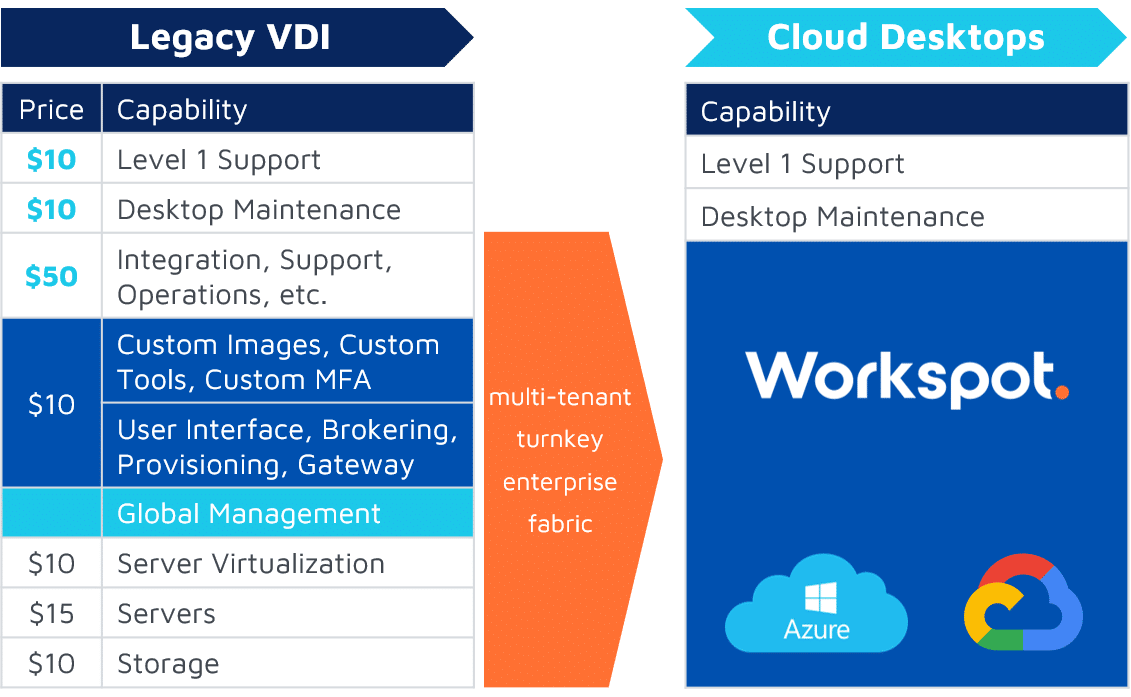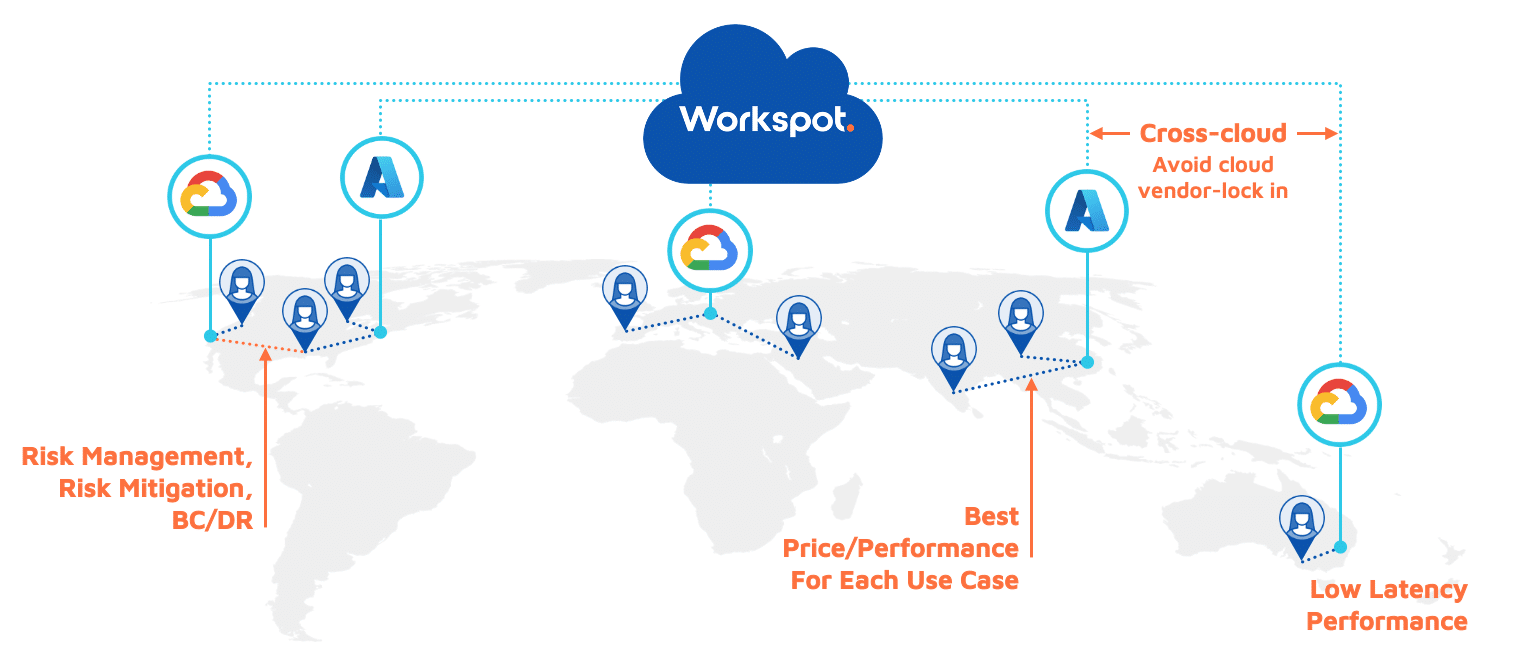In the early days of VDI, the promise of its simplicity, security, and reliability benefits was alluring. Virtualize and centralize the Windows desktop in the data center. Any user can use any device to securely access their business applications from anywhere in the world. Of course, the reality was quite different. Year after year we heard the question asked: “Is this the year of VDI?” Despite the hype, it just never became mainstream, and the reasons are pretty clear. The legacy VDI stack is enormously challenging for IT teams. A cross-functional team of server, storage, desktop, networking and security engineers could spend months designing and implementing a complex solution stack. Yet, despite all these valuable resources weighing in, inevitably there are issues with availability. When something breaks and users cannot reach their desktops, it becomes a multi-dimensional problem to try to determine the root cause of the outage. If complex implementation and troubleshooting aren’t enough, to top it off, end-users typically experience poor performance. Business leaders end up unhappy because it takes so long (if ever) to realize any value, and it turns out that despite claims to the contrary, these legacy solutions are too rigid to scale and keep up with the dynamics of the business.
It has been a rough road for VDI and especially for the organizations that have struggled with their implementations. The complex, do-it-yourself (DIY) model, using a solution stack built for a single customer in a single data center, is no longer relevant in the cloud era. What’s readily doable today goes leaps and bounds beyond the promises of legacy VDI to deliver real business value – fast. Here’s how.
SaaS Cloud PCs in the Fast Lane
So, if you take a look at the VDI stack in terms of capabilities, there are three broad areas to examine – infrastructure (servers, storage, and virtualization), legacy VDI software and finally, the integration & operations needed to run the solution. Even though a lot of attention is often focused on the legacy VDI software stack, the overall solution cost & complexity stems primarily from the integration and ongoing operation of the VDI stack.
The Workspot Enterprise Desktop Cloud is the first virtual desktop solution built for the public cloud era. It’s turnkey SaaS that modernizes legacy VDI. Because we deliver virtual desktops as a service, you don’t have to deal with any of the complexity anymore. We do it for you. Plus, it’s important to note that we invented cloud-native virtual desktops; we are not just running someone else’s technology. The close partnerships we have with our customers are enabled by a very short feedback loop. Your pilot can be up and running in a few days, and your production rollout live in 30-90 days, depending on the complexity of your enterprise requirements. Our Go-Live Deployment Services cover helping you roll out your first production use case to the first set of users. As a company, we are focused on your business success, because that’s the only way we can all be successful. So we include the services needed to take you live into the cost of your subscription fee. Our solution is priced at a flat rate per user – the rate depends on the configurations you choose for your cloud desktops and workstations. Finally, we take full responsibility for the SLA of your Cloud PCs – all the elements in the blue box in the picture below, including the availability of the public cloud. Imagine what you can do with all those IT resources you can free up!
Old Way New Way
It’s time to modernize VDI with Cloud PCs.
Now, inventing a cloud-native, SaaS Cloud PC platform is a tough problem, because a true SaaS service has to be multi-tenant and turnkey, and this necessitates building the solution from scratch. Legacy, single-tenant, DIY, on-premises VDI architectures cannot be evolved into a cloud-native SaaS service. Multiple legacy software vendors have tried and failed with this approach – witness Siebel, BMC, Peoplesoft and others.
You can build a great cloud-native service in one data center. But the public cloud adds another strategically important dimension which is at the crux of realizing business value: the ability to take advantage of the edge of the cloud.
A New Virtual Desktop Architecture is Required for the Public Cloud Era
If you look at all legacy software stacks – databases, app servers, and VDI – they were built for a single data center, and with great difficulty and a ton of IT resources, customers operated them in 2-3 data centers. Often this was done with replicated instances and management. The public cloud offers each customer the ability to run software in tens of cloud regions worldwide – essentially you have tens of data centers available to you. These cloud regions are also connected using the best, fastest, most reliable networks. A completely new, built-from-the-ground-up architecture was needed to take advantage of the massive scale of the public cloud, because you simply cannot install and operate 50 copies of everything and hope to succeed. So, that’s what we built; the Workspot Desktop Control Fabric™ a cloud-native, globally distributed architecture that allows you to scale horizontally across cloud regions – in minutes. That is a massive innovation in the VDI space that is fundamentally transforming how companies do business and how they grow.
The Desktop Control Fabric – Only from Workspot
The diagram below illustrates what’s possible as organizations take advantage of cloud-scale virtual desktops. With other Cloud PC solutions, you need specialized public cloud skills, because you’ll have to deal with compute, storage, networking, and images in each cloud region. Your costs will vary in each cloud region, and they will add up to what could be an unpleasant surprise.
First and foremost, Workspot’s mission is to alleviate VDI complexity and reduce the costs of operating virtual desktops, so we built an Workspot Desktop Control Fabric™, a global, elastic architecture that abstracts and simplifies the public cloud for virtual desktop use cases. Today your organization has access to more than a hundred cloud regions – and counting. With Workspot’s SaaS Cloud PC platform, you simply select the cloud regions closest to your users, then select yourCloud PC configurations – how many CPUs, how much memory, and how much storage for each. Then, you leave the rest to us! It’s our job to deliver on the SLA of your Cloud PCs globally.We also help you manage the costs whether you’ve chosen a flat-pricing or pay-as-you-go model.
Additionally, you have the opportunity to map the unique requirements for each of your use cases to the Cloud PC best suited for the job. You might want persistent Windows 10/11 desktops for your developers and CAD designers. You might want non-persistent desktops or Windows application access for your call center agents; some users need GPUs, some don’t. And so on…
Finally, even though your end users are distributed across the globe, they experience great performance because their desktops and data are located in the nearest cloud region. When was the last time you heard that VDI performance is better than a local desktop or workstation? Never? We hear this every day about our Cloud PCs and workstations.
Workspot’s global, multi-cloud Desktop Control Fabric is a massive innovation for virtual desktops.
It’s really important to note that Workspot helps IT manage all the layers – cloud, fabric, use cases, and users – through a single pane of glass. No one else can do this.
The fabric has obvious benefits for creating a global Cloud PC footprint, including fast time to value and great performance for your users, but those benefits are just the beginning. For example, the elastic nature of the fabric reduces end-user desktop provisioning time dramatically, especially when integrated with your favorite IT service catalog, such as ServiceNow. Also, deep instrumentation embedded in every layer of the Cloud PC stack allows for intelligent, real-time root cause and blast radius analysis – on a global scale – to meet the most demanding SLAs.
Ready to talk with Workspot about your use case requirements? We can help you ask the right questions of all the vendors you evaluate to ensure the solution you choose sets you up for success. Schedule a demo now!
The Cloud Desktop Fabric is a trademark of Workspot, Inc. and is patent pending.
Cloud Native Architecture






